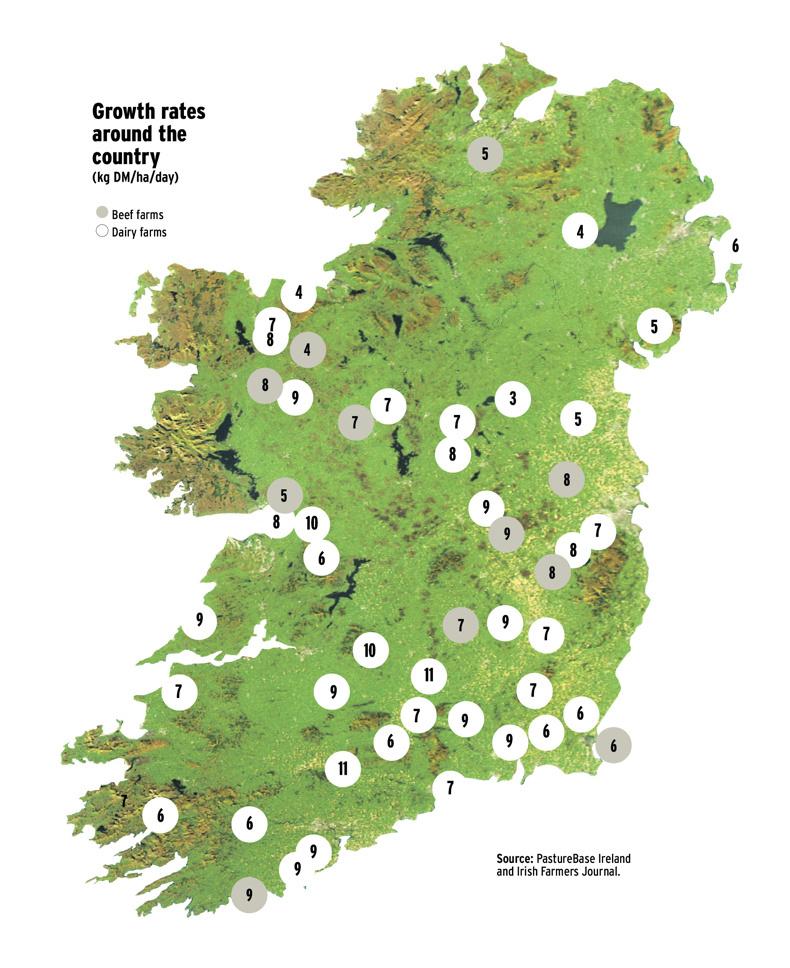The weather over the last few days has been good in most places, and the long-range weather forecast is good also. It’s an ideal opportunity to get cows and fertiliser out, if they haven’t already been let out or fertiliser already spread.

There is an abundance of grass on most farms so cows should be let out day and night. If it’s dry enough to let cows out by day, it’s dry enough to let them out by night.
Don’t worry, cows aren’t afraid of the dark. You won’t run out of grass by grazing in February. In fact, you will grow more grass in March and April if you graze 30 or 40% of the farm in February.
Many farmers have less area grazed than target so far in February.
This is due to a combination of higher pre-grazing yields and slightly later calving on many farms. You need to start grazing on lower covers to the get the area grazed up.
The question is should dry cows and weanlings be used to increase the area being grazed? To answer this question properly, you need to have a grass budget done and see the impact on average farm cover of grazing paddocks with other stock now.
If on PastureBase, change the cover on some paddocks that you could graze with other stock to zero.
Then go into the feed budget and see what the predicted average farm cover is at the end of March and early April.
If it’s within the 500 to 600kg/ha then you can afford to graze these paddocks.
The best policy is to leave out a lot of dry cows at once and get them grazed off within a day or two. Never leave out cows that are full of silage.
They’ll have no interest in grazing and will just waste grass instead. Lock cows away from silage for five or six hours before being turned out.
On fertiliser, if you haven’t spread anything to date I would go with around 35 to 40kgN/ha (28 to 32 units/acre).
As always in spring, the product of choice is urea. Spread the whole farm, including the heavy covers, but skip over paddocks that got slurry. Every 2,500 gallons/acre of slurry is equivalent to about 30kgN/ha.
Ground conditions are good and the forecast is good for the next week.Start off grazing in lighter covers to increase the area being grazed.Make sure cows are hungry before they go out grazing.Allocate grass in square blocks and back-fence to prevent damage.
Read more
Mild conditions offer turnout opportunities
The weather over the last few days has been good in most places, and the long-range weather forecast is good also. It’s an ideal opportunity to get cows and fertiliser out, if they haven’t already been let out or fertiliser already spread.

There is an abundance of grass on most farms so cows should be let out day and night. If it’s dry enough to let cows out by day, it’s dry enough to let them out by night.
Don’t worry, cows aren’t afraid of the dark. You won’t run out of grass by grazing in February. In fact, you will grow more grass in March and April if you graze 30 or 40% of the farm in February.
Many farmers have less area grazed than target so far in February.
This is due to a combination of higher pre-grazing yields and slightly later calving on many farms. You need to start grazing on lower covers to the get the area grazed up.
The question is should dry cows and weanlings be used to increase the area being grazed? To answer this question properly, you need to have a grass budget done and see the impact on average farm cover of grazing paddocks with other stock now.
If on PastureBase, change the cover on some paddocks that you could graze with other stock to zero.
Then go into the feed budget and see what the predicted average farm cover is at the end of March and early April.
If it’s within the 500 to 600kg/ha then you can afford to graze these paddocks.
The best policy is to leave out a lot of dry cows at once and get them grazed off within a day or two. Never leave out cows that are full of silage.
They’ll have no interest in grazing and will just waste grass instead. Lock cows away from silage for five or six hours before being turned out.
On fertiliser, if you haven’t spread anything to date I would go with around 35 to 40kgN/ha (28 to 32 units/acre).
As always in spring, the product of choice is urea. Spread the whole farm, including the heavy covers, but skip over paddocks that got slurry. Every 2,500 gallons/acre of slurry is equivalent to about 30kgN/ha.
Ground conditions are good and the forecast is good for the next week.Start off grazing in lighter covers to increase the area being grazed.Make sure cows are hungry before they go out grazing.Allocate grass in square blocks and back-fence to prevent damage.
Read more
Mild conditions offer turnout opportunities








 This is a subscriber-only article
This is a subscriber-only article









SHARING OPTIONS: